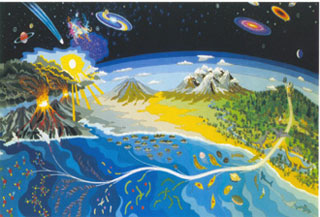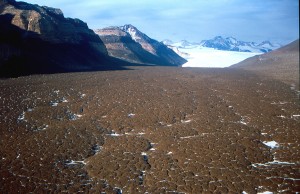Does my science look big in this? The astrobiology edition

During the 20th century a powerful new idea gradually entered our consciousness and culture: cosmic evolution. We are all par of a huge narrative: a cosmos billions of years old and billions of light years in extent. It is this idea that caught my attention this month via the proceedings of the Sao Paulo Advanced School of Astrobiology SPASA 2011, published in the October International Journal of Astrobiology.
Although the question of extraterrestrial life is very old, the concept of full-blown cosmic evolution – the connected evolution of planets, stars galaxies and life on Earth and beyond – is much younger. In a rather breathtaking paper, Steven Dick formerly of the Aerospace History at the National Air & Space Museum places his arguments for cosmic evolution. Dick traces the idea from its roots in the 19th century theories of Pierre-Simon Laplace and Robert Chambers through its philosophical, astronomical, and biological upbringing to the present day. He examines evolution, the worldview that it had become in the 1950s and 1960s and how it had permeated culture in numerous ways and different cultures in diverse ways. Dick cautions us though noting “we need to remember that ‘culture’ is not monolithic and that ‘impact’ is a notoriously vague term.”

In addition to the impact of our new understanding on culture, cosmic evolution also provides a window on long-term human destiny, asserts Dick. He presents this idea via three scenarios, the: the physical , biological, and postbiological universe. Life is unique to earth in the physical universe scenario, and the options flow from this situation – think of Isaac Asimov’s Foundation series. We will certainly interact with extraterrestrials in the biological universe – here cosmic evolution commonly ends in life, mind and intelligence. Cultural evolution in a biological universe may replace biologicals with artificial intelligence creating what Dick calls a postbiological universe. We do not know yet, which of these is our reality, that is one of the challenges of astrobiology, maintains Dick.
In a second ‘big-picture’ paper Marcelo Gleiser presents his four ages of astrobiology. For Gleiser the influx of astrophysical data, particularly on the prevalence of exoplanets “indicates that there are plenty of potentially life-bearing platforms within our galaxy.” He then presents the ‘history’ of life in the universe in terms of the steps needed for matter to have sequentially self-organised into more and more complex structures. His sequence is best viewed as a prelude to the physical or biological universe scenarios of Dick. Gleiser’s fourth age, the Cognitive Age (the age of thinking biomolecules), really addresses whether we are unique or not i.e. which of Dick’s two scenarios, the physical or biological are reality. Gleiser’s first three ages: physical, the creation of stars and planets from atomic nuclei; chemical, in which elements organise into biomolecules; and thirdly biological, in which living creatures of growing complexity form from biomolecules. the papers by Dick and Gleiser are both papers heady and exhilarating conceptual reads.
Jorge Horvath and Douglas Galante accept the premiss that life exists, and then argue we need to take high-energy astrophysical events seriously. Scientists and the public account for meteor impacts in both academic studies, science-fiction writing and film – not so for events such as supernovae, gamma-ray bursts and flares. They show that these events are more frequent than asteroid strikes and that the effects are non-negligible (academic speak for potentially fatal to planet based species). They conclude that just because we have not yet been wiped out by such events can be seen as either a measure of earthlife’s resilience or a threat we are statistically yet to encounter.
My attention was captured by two other papers from the proceedings. Martin Brasier and David Wacey address the problem of studying life in deep space – comparing it to study of life remote in time. This view is pertinent, as it is non-trivial for scientists to determine what is a viable signal of extinct life. The authors develop a set of protocols and then apply these to earth samples, of varying ages. They do this to show how we could interpret similar samples, where much of the desirable information (the context) has been filtered out during the process of transmission (either physical or data) across vast distances of space, or time or both (as is likely on Mars). Even 10 years ago these questions were moot, but we have learned much over the recent past about metabolic pathways and living microbial systems. Brasier and Wacey conclude that there is still work required on pseudo-fossils, structures that arise naturally within complex physico-chemical systems, so that we can confidently agree on signs of life that are remote in space and time.

My final pick is an experimental paper that looks at the ExoMars mission. The European Space Agency and (initially NASA ) ExoMars mission is scheduled for launch in 2018 – specifically to detect life signatures on the surface and subsurface of Mars. This probe will carry, for the first time, a Raman spectrometer, a technique with proven ability to determine the spectral signals of key biochemicals. The authors support these assertions by assessing samples acquired from Arctic and Antarctic cold deserts and a meteorite crater. These terrestrial environments are similar to those found on Mars. The experimental results presented in this paper demonstrate that it will be possible using this technique to assess and detect spectral signals of extra-terrestrial (Mars in this case) extremophilic life signatures.
Orrman-Rossiter K (2012-11-09 00:07:51). Does my science look big in this? The astrobiology edition. Australian Science. Retrieved: Dec 05, 2025, from https://ozscience.com/biology/does-my-science-look-big-in-this-the-astrobiology-edition/
 Follow
Follow
2 thoughts on “Does my science look big in this? The astrobiology edition”
Comments are closed.